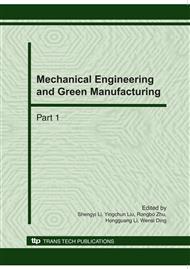[1]
N. Johnson and D. Hogg. Learning the distribution of object trajectories for event recognition. In BMVC '95: Proceedings of the 6th British conference on Machine vision (Vol. 2), pages583-592, Surrey, UK, UK, 1995. BMVA Press.
DOI: 10.5244/c.9.58
Google Scholar
[2]
C. Stauffer andW. E. L. Grimson. Learning patterns of activity using real-time tracking. Transactions on Pattern Analysis and Machine Intelligence, 22(8): 747-757, (2000).
DOI: 10.1109/34.868677
Google Scholar
[3]
Z. Rasheed and M. Shah, Detection and representation of scenes in videos, IEEE Trans. Multimedia, vol. 7, no. 6, pp.1097-1105, Dec. (2005).
DOI: 10.1109/tmm.2005.858392
Google Scholar
[4]
]A. Hanjalic, R. L. Lagendijk, and J. Biemond, Automated high-level movie segmentation for advanced video-retrieval systems, IEEE Trans. Circuits Syst. Video Technol., vol. 9, no. 4, pp.580-588, June1999.
DOI: 10.1109/76.767124
Google Scholar
[5]
M. Yeung, B. Yeo, and B. Liu, Segmentation of videos by clustering and graph analysis, Comput. Vis. Image Understand., vol. 71, no. 1, pp.94-109, July (1998).
Google Scholar
[6]
T. M. Cover and J.A. Thomas. Elements of Information Theory. John Wiley and Sons, New York, 1991. ).
Google Scholar
[7]
Z. Cernekova,I. Pitas, and C. Nikou. Information theory-based shot cut/fade detection and video summarization[J]. IEEE Transactions on Circuits and Systems for Video Technology, 16(1): pp.82-91, (2006).
DOI: 10.1109/tcsvt.2005.856896
Google Scholar
[8]
T. Lin and H. -J. Zhang. Automatic video scene extraction by shot grouping[C]. in Proc 15th Int Conf Pattern Recognition, vol. 4. Spain, Sept. 2000. 39-42.
DOI: 10.1109/icpr.2000.902860
Google Scholar
[9]
T. Liu, H. J. Zhang, and F. Qi, A novel video key-frame extraction algorithm based on perceived motion energy model, IEEE Trans. Circuits Syst. Video Technol., vol. 13, no. 10, pp.1006-1013, Oct. (2003).
DOI: 10.1109/tcsvt.2003.816521
Google Scholar
[10]
H. C. Shih and C. L. Huang, Content-based multi-functional video retrieval system, Int. Conf. Computers in Education, pp.383-384, Jan. (2005).
Google Scholar
[11]
T. Lin and H. -J. Zhang. Automatic video scene extraction by shot grouping[C]. in Proc 15th Int Conf Pattern Recognition, vol. 4. Spain, Sept. 2000. 39-42.
DOI: 10.1109/icpr.2000.902860
Google Scholar
[12]
(Alan Hanjalic. Automated High-Level Movie Segmentation for Advanced Video-Retrieval Systems[J]. IEEE transactions on circuits and systems for video technology . 1999, (9): 580-588.
DOI: 10.1109/76.767124
Google Scholar


